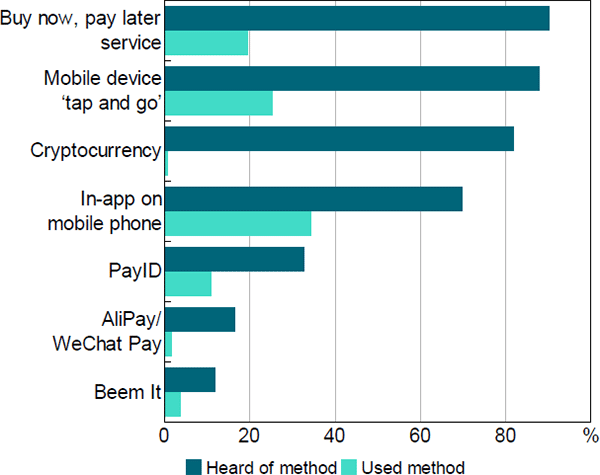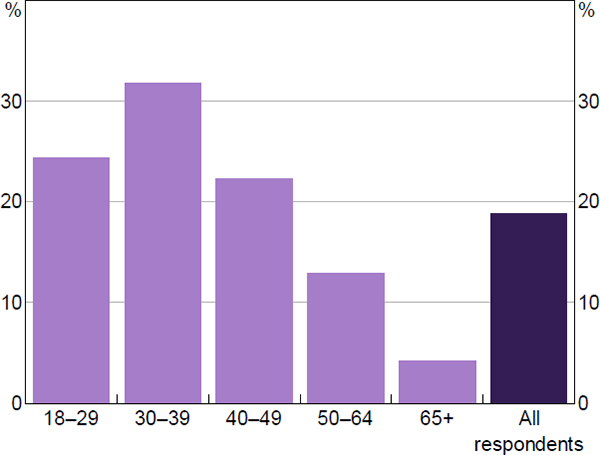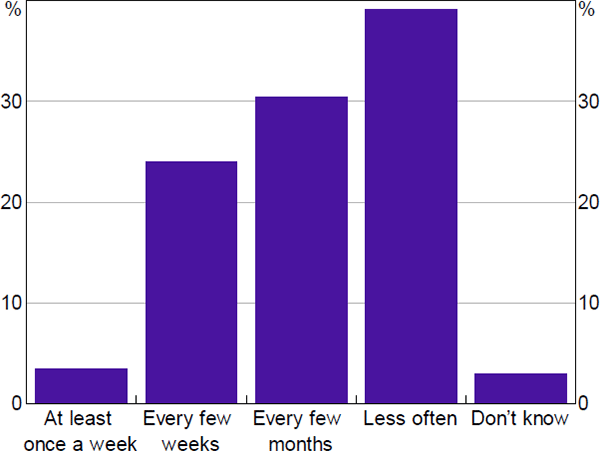RDP 2020-06: Consumer Payment Behaviour in Australia: Evidence from the 2019 Consumer Payments Survey 8. Innovation in Payments
September 2020
- Download the Paper 1,620KB
8.1 Alternative Payment Methods
Australian consumers have access to a wider range of electronic alternatives to cash and traditional (plastic) cards than they did even a few years ago. A number of innovative new products and services have emerged or attracted increased attention, often facilitated by mobile technology. Many of these new payment services make use of existing card networks – for example, by using stored card details ‘in the background’ – but enable consumers to use cards in new ways. An example of this is the use of linked debit or credit cards to fund instalment payments for purchases made with BNPL services. Other innovations have involved the creation of new networks to facilitate payments, most notably the introduction of the New Payments Platform (NPP) which has provided consumers with the ability to make real-time, data-rich account-to-account bank transfers using PayIDs.[30]
To gauge awareness and use of some of these newer means of payment, the CPS asked respondents whether they had heard of a number of alternative payment options and, if so, whether they had used them at least once in the previous 12 months.
In terms of awareness, most respondents had heard of several of the newer payment technologies, with awareness highest for BNPL services, at 90 per cent, and cryptocurrency (82 per cent) (Figure 31). Cryptocurrencies (e.g. Bitcoin) are designed as an alternative means of payment to sovereign currencies and may also be held for investment or speculative purposes.[31] Although many respondents had heard of cryptocurrencies, very few (less than 1 per cent) had used a cryptocurrency such as Bitcoin to actually make a consumer payment over the previous year.[32] Awareness was also relatively high for mobile-enabled payments such as mobile device ‘tap and go’ payments (88 per cent; see Section 5.2) and in-app payments on a mobile phone (70 per cent; see Section 6.1).

Note: ‘Used method’ is the share of respondents who reported using a method in the past 12 months
Source: RBA calculations, based on data from Roy Morgan Research
A number of other non-traditional means of payment were neither widely recognised by consumers nor commonly used to make payments. For example, AliPay and WeChat Pay – which are very popular digital wallet services in China – had only been used by 1.5 per cent of CPS participants in in the previous 12 months.[33] Most respondents had not heard of Beem It, an app owned by several large Australian financial institutions that facilitates person-to-person transactions. While relatively few people indicated that they had heard of or used PayID as a way of addressing NPP payments (33 and 11 per cent, respectively), this is likely to underestimate the use of the NPP service overall because people may not be aware that many of their bank transfers may be processed through this system (discussed further below).
A notable development in the Australian retail payments system over the past few years has been the emergence of BNPL services. These services enable consumers to obtain goods and services immediately and make subsequent payments in a series of interest-free instalments, typically drawn from a linked debit or credit card.[34] As noted, most respondents had heard of BNPL services, and just under 20 per cent reported that they had made at least one BNPL payment over the previous year (Figure 32). According to the CPS, consumers aged between 30 and 39 were most likely to have used BNPL at least once over the previous year (32 per cent), with over 20 per cent of respondents aged between 18–29 and between 40–49 also reporting that they had used BNPL in the previous year (Figure 32).

Source: RBA calculations, based on data from Roy Morgan Research
Overall, people who had used BNPL reported that they typically made payments using these services infrequently; 70 per cent of users paid with BNPL every few months or less often, while only 3 per cent used BNPL at least once a week (Figure 33). Younger people tended to use BNPL more frequently than those in older age groups, with 35 per cent of BNPL users aged under 30 using these services at least once a week or every few weeks. The relatively low frequency with which BNPL services are used by most consumers is likely to partly reflect the nature of the purchases made with these services. For example, to date BNPL has been mostly available for ‘discretionary’ retail purchases, whereas it is not typically accepted at businesses such as supermarkets or other food retailers.

Source: RBA calculations, based on data from Roy Morgan Research
If participants in the CPS had heard of but not used an alternative payment method, they were asked about their reasons for not using it. Of these respondents, the majority reported that one of the main reasons was because they felt that their existing payment methods met their needs. For example, 78 per cent of people who were aware of BNPL said their existing methods met their needs, with concerns about spending control (23 per cent) and a lack of knowledge or tools to use the method the next most commonly cited reasons for not using BNPL (Figure 34). Those who hadn't used cryptocurrency or contactless mobile device payments were relatively more likely to cite a lack of knowledge or tools as well as privacy and/or security concerns as reasons for not using those methods.

Note: Bars do not sum to 100 per cent as respondents could choose more than one answer and response of ‘Other reason’ not shown
Source: RBA calculations, based on data from Roy Morgan Research
8.2 Person-to-person Payments
The way in which people can make person-to-person payments to family and friends (transfers) has changed significantly because of the introduction of new technologies. Since its launch in February 2018, the NPP has allowed customers of more than 90 financial institutions to make fast data-rich payments 24 hours a day; over 66 million Australian bank accounts are able to make and receive payments through the NPP (Fitzgerald and Rush 2020). Separately, mobile apps have been developed to facilitate quick and easy transfers to friends and family (e.g. Beem It) and even provide pocket money.
These new payment technologies have facilitated a shift to transferring money electronically using mobile apps rather than providing cash. While the overall number of peer-to-peer transfers has remained steady as a share of consumer payments since 2013 (2 per cent of the number of consumer payments), mobile and app-based transfers accounted for 40 per cent of transfers, compared to 10 per cent in 2013 (Figure 35).[35] The increase in the use of mobile technology for transfers has been led by younger age groups, with respondents aged under 30 making two-thirds of their transfers using apps.

Source: RBA calculations, based on data from Colmar Brunton, Ipsos and Roy Morgan Research
8.3 Transport Cards
In addition to increased information on alternative payment methods, the 2019 CPS collected information on the use of pre-paid transport cards such as Myki and Opal for the first time.[36] These types of cards have been rolled out across many public transport systems in Australia, though more recently some public transport terminals have enabled fares to be paid directly by tapping a debit or credit card on the terminal rather than a specific transport card. In the interest of ensuring comparability with previous survey waves, the analysis in the preceding sections does not include payments made with transport cards. In 2019, these payments were equivalent to 2 per cent of the number and 0.1 per cent of the value of consumer payments. The vast majority of transport-related payments are now made electronically, with cash accounting for less than 10 per cent of transport payments under $10 during the week of the diary.
Footnotes
A PayID is a simple unique identifier which links to a customer's transaction account so that fast payments can be made to that account through the NPP; a PayID is often an email address, phone number or ABN. See Rush and Louw (2018) for an overview of the NPP and the Fast Settlement Service. [30]
See Dark et al (2019) for further discussion of cryptocurrencies. [31]
Only 3 per cent of respondents reported holding cryptocurrency. [32]
Anecdotally, these services tend to mostly be used by Chinese visitors to Australia and accepted by businesses that cater to tourists. [33]
Prominent BNPL services include AfterPay and ZipPay and there have been a number of new entrants into this market in recent years. [34]
The definition of an app-based payment has changed over survey years. In 2019, we asked whether consumers made a payment online, or through an app. In 2016 and 2013, we asked if a payment was made online by a smartphone/SMS payment. [35]
Previous survey waves captured ‘top-ups’ of transport cards, rather than when the card was used for an individual trip; this survey captures both ‘top-ups’ and individual transport card use. [36]